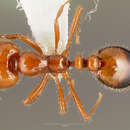en
names in breadcrumbs


Taxonomic history
Wheeler, 1915b PDF: 396 (m.); Wheeler & Wheeler, 1955c PDF: 133 (l.); Taber & Cokendolpher, 1988 PDF: 95 (k.).Junior synonym of Solenopsis geminata: Mayr, 1886d PDF: 460; Dalla Torre, 1893 PDF: 76.Revived from synonymy as subspecies of Solenopsis geminata: Wheeler, 1910a PDF: 563; Wheeler, 1915b PDF: 395.Revived status as species: Creighton, 1930b PDF: 98; Creighton, 1950a PDF: 232; Snelling, 1963 PDF: 9.Senior synonym of Solenopsis maniosa: Trager, 1991 PDF: 166.Senior synonym of Solenopsis pylades: Trager, 1991 PDF: 166.
The southern fire ant (Solenopsis xyloni), also known as the Californian fire ant or cotton ant,[1]: 89 is a stinging fire ant native to southern parts of the United States.[2][3][4] Its behaviour is similar to the red imported fire ant (S. invicta), although its sting is less painful. It has a broad and opportunistic diet, and will store seeds in its nest and eat honeydew collected from other insects.[1]: 91 [5][6]
The southern fire ant shares its range with the red imported fire ant (S. invicta), the golden fire ant (S. aurea) and S. amblychila. The southern fire ant has the widest distribution of these, occurring from the Carolinas to California, including Georgia, lowland Tennessee, Arkansas, and southern Kansas.[1]
{{cite web}}: CS1 maint: archived copy as title (link) The southern fire ant (Solenopsis xyloni), also known as the Californian fire ant or cotton ant,: 89 is a stinging fire ant native to southern parts of the United States. Its behaviour is similar to the red imported fire ant (S. invicta), although its sting is less painful. It has a broad and opportunistic diet, and will store seeds in its nest and eat honeydew collected from other insects.: 91
The southern fire ant shares its range with the red imported fire ant (S. invicta), the golden fire ant (S. aurea) and S. amblychila. The southern fire ant has the widest distribution of these, occurring from the Carolinas to California, including Georgia, lowland Tennessee, Arkansas, and southern Kansas.
La hormiga de fuego del sur (Solenopsis xyloni), también conocida como "hormiga de fuego de California" u "hormiga de algodón", es una "hormiga de fuego", género Solenopsis nativa de las partes meridionales de los Estados Unidos.[1][2][3] Su comportamiento es similar a la hormiga de fuego roja importada (S. invicta), aunque su picadura es menos dolorosa. Tiene una dieta amplia y oportunista, almacena las semillas en su nido y come melaza recolectada de otros insectos.[4]
La hormiga de fuego del sur comparte su rango con la hormiga de fuego roja importada (S. invicta), la hormiga de fuego dorada (S. aurea) y S. amblychila. La hormiga de fuego del sur tiene la distribución más amplia de éstos, ocurriendo desde las Carolinas a California, incluyendo Georgia, Tennessee, Arkansas, y Kansas meridional.[5]
La hormiga de fuego del sur (Solenopsis xyloni), también conocida como "hormiga de fuego de California" u "hormiga de algodón", es una "hormiga de fuego", género Solenopsis nativa de las partes meridionales de los Estados Unidos. Su comportamiento es similar a la hormiga de fuego roja importada (S. invicta), aunque su picadura es menos dolorosa. Tiene una dieta amplia y oportunista, almacena las semillas en su nido y come melaza recolectada de otros insectos.
La hormiga de fuego del sur comparte su rango con la hormiga de fuego roja importada (S. invicta), la hormiga de fuego dorada (S. aurea) y S. amblychila. La hormiga de fuego del sur tiene la distribución más amplia de éstos, ocurriendo desde las Carolinas a California, incluyendo Georgia, Tennessee, Arkansas, y Kansas meridional.
Solenopsis xyloni is een mierensoort uit de onderfamilie van de Myrmicinae.[1][2] De wetenschappelijke naam van de soort is voor het eerst geldig gepubliceerd in 1879 door McCook.
Bronnen, noten en/of referentiesSolenopsis xyloni é uma espécie de formiga do gênero Solenopsis, pertencente à subfamília Myrmicinae.[1]
Solenopsis xyloni é uma espécie de formiga do gênero Solenopsis, pertencente à subfamília Myrmicinae.
Solenopsis xyloni là một loài kiến thường thấy được ở vùng phía Nam Hoa Kỳ.[1]
|coauthors= bị phản đối (trợ giúp)
Solenopsis xyloni McCook, 1879[1]
СинонимыSolenopsis xyloni (лат.) — вид жалящих муравьёв из группы опасных огненных муравьёв (Solenopsis, Solenopsidini). Северная Америка.
Длина полиморфных рабочих 1,6—5,8 мм (самки до 8 мм), окраска от желтовато-красной до чёрной. Усики 10-члениковые с булавой из двух сегментов. Проподеум невооружённый, без зубцов или шипиков. Между грудкой и брюшком расположен тонкий стебелёк, состоящий из двух члеников (петиоль + постпетиоль)[2][3].
Диплоидный набор хромосом 2n = 32[4].
Встречается в Мексике и США[5].
Вид был впервые описан в 1879 году, затем в 1893 году (Dalla Torre, 1893) сведен в синонимы к Solenopsis geminata, а в 1910 году американский мирмеколог Уильям Уилер придал ему статус подвида (Solenopsis geminata xyloni). В современном статусе самостоятельного вида с 1930 года (Creighton, 1930)[6]. Кладистический анализ с использованием данных ДНК показал, что Solenopsis xyloni вместе с тропическим огненным муравьём (Solenopsis geminata) относится к комплексу близких видов Solenopsis geminata complex (Solenopsis aurea, Solenopsis geminata, Solenopsis xyloni и другие виды), который вместе с красным огненным муравьём (Solenopsis invicta) и несколькими родственными видами (Solenopsis saevissima Smith, 1855, Solenopsis daguerrei Santschi, 1930, Solenopsis richteri Forel, 1909, и другими) относится к группе видов Solenopsis saevissima species-group[7][2][8].
Solenopsis xyloni (лат.) — вид жалящих муравьёв из группы опасных огненных муравьёв (Solenopsis, Solenopsidini). Северная Америка.